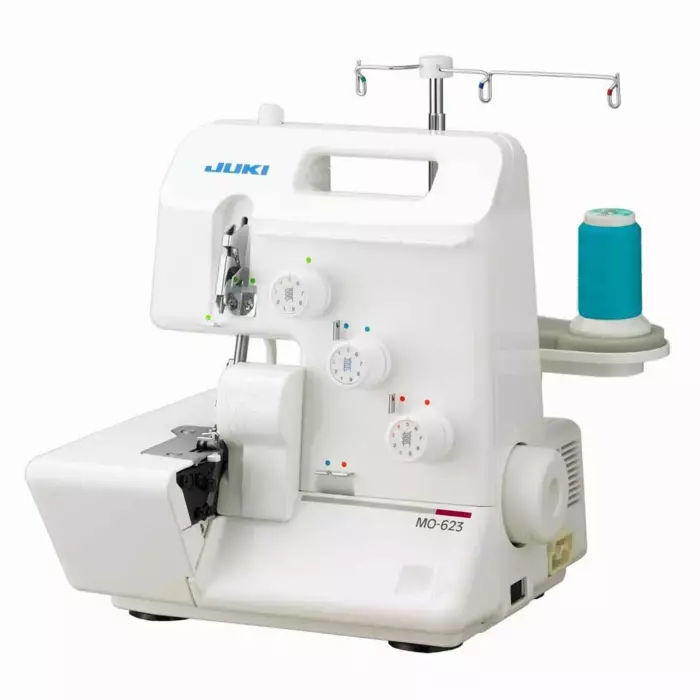
JUKI MO-623 Garnet Series Serger 2/3 Thread Overlock With Rolled Hem
Our Price:
$379.99
Market Price:
$499.99
Sold Out
If you haven’t considered using a serger to supplement your regular sewing machine, Juki’s new Garnet Series MO-623 may change your mind. No matter what you’re stitching up, the Juki MO Garnet series is designed to be easy to thread and use so that you can have the serger advantage. This durable and dependable Juki serger will help you expand your repertoire of projects with ease.
We have a wide range of sergers, from Juki’s MO-623 to the most advanced industrial model. If you’re considering a Juki but don’t know which model would be the right one for you, call us at 1-800-868-4419. We’ll be happy to answer all your questions.
The Juki MO-623 is a simple-to-operate machine and an excellent starter for home and professional sewers. With color-coded thread guides, simply match up the threads from the stand into the machine.
The upper/lower knife system has a dedicated drive with dial adjustment for clean and consistent cutting every time.
Fast seaming and built-in rolled hem, no need to change foot or settings.
Although we carry larger Juki serger machines, like the industrial model MO-6843S, which can handle six threads at once, the MO-623 is smaller, easier to operate, and only uses three threads. At a cost that’s hundreds less than the six-thread industrial model, Juki’s MO-623 is a more compact and affordable model for both home and shop sewers.
The JUKI MO-623 can handle:
Now you know what the JUKI MO-623 can do, you can take your sewing to the next level and have professional looking and lasting results.
A serger is a machine that sews fabric with an overlocking stitch, sews, and finishes the seam in one pass. Great for knit fabrics.
Many home sewing machines have “stretch stitches,” but they are not as strong as an overlocking stitch. When added to a seam, this finishing stitch also overlocks the seam so it won’t fray. The serger stitches move and stretch where they need to so there are no gaps as the fabric moves.
Industrial machines are “one-trick ponies,” meaning they do one thing only, like stitches, buttonholes, bar-tacking, zippers, or other single functions.
Sergers make seaming, seam trimming and rolled hems much faster and easier than using a standard home or industrial machine. They move so fast through even the longest seams.
Juki’s MO series is a great starter machine for home, hobby and professional sewers. Top sewing speed of 1,500 spm means you can sew much faster.
While it looks intimidating, threading the Juki MO-623 isn’t tricky.
The color-coded thread guides tell you which thread goes where—needle, upper, and lower. Starting at the thread stand, follow the blue, red, and green dots for the upper, lower, and needle thread. The MO-623 holds three cones, the larger of which will have about 3,000 yards of thread.
If you’ve threaded the machine incorrectly, removing all the threads and starting over is best.
Seams are easy and fast—you sew the seam, trim the seam allowance, and overcast the edge all at once and be done with it. Your seam won’t unravel as it might with a standard domestic or industrial sewing machine.
You can also overcast a raw edge of the fabric before hemming or other stitching work. Adjust the machine for this overcast type (see the instruction manual), and the knife trims a neat, clean edge. Then, just finish the hem on your regular sewing machine.
Remember that the Juki MO-623 (and any serger) only sews in one direction: forward. It doesn’t backstitch like a domestic machine and has fewer options than a home machine. The serger also has no bobbin since it works to intertwine threads from the top.
In an industrial setting, each machine has a single function: coverstitch, lockstitch, buttonhole, zipper, bar-tacking, etc. A home machine has many of these functions built-in or uses a series of cams to produce them.
A serger stitches seams along with an overlock stitch trims seam allowances and encases a seam to prevent fraying in one stitching action. There’s no need to use pinking shears or re-stitch seams with a zigzag edge.
The Juki MO-623 has long tweezers to access thread that goes into or comes out of difficult-to-reach spots. Once you become comfortable with the machine, you’ll use it with ease.
Unlike a regular sewing machine, you’ll start and end your seams with “chaining” or leaving a short “chain” on both ends of the fabric. You’ll then secure the “chaining” with additional stitching or another method to prevent unraveling.